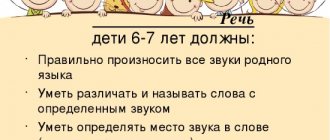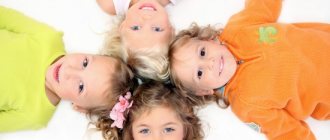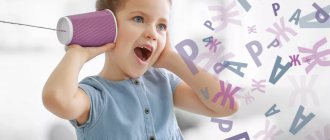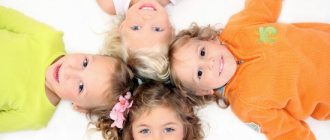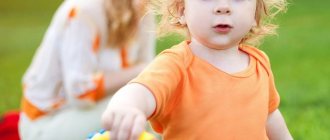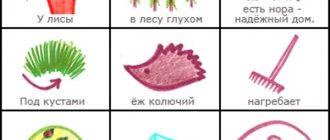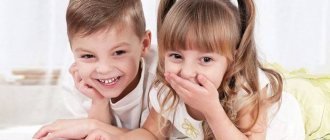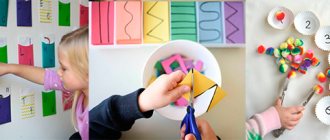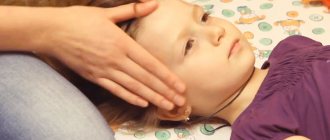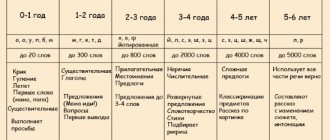Often, parents believe that there is no need to think about the development of the child’s speech if obvious pronunciation defects do not appear (the child has a lisp or does not speak at all). However, many problems in the future can be avoided, and a child’s literate and clear speech can be formed, if you start paying attention to speech development as early as possible throughout the entire period (before one year, and at one year, and at two, and at three...).
Speech development is not at all about working on individual broken sounds or expanding vocabulary, as is commonly thought. The formation of speech depends on the activity of many areas of the brain, so you need to work in all areas: develop fine motor skills, enrich sensory experience, work on articulation, breathing, increase vocabulary, and much more.
I have already written more than once about games that promote speech development in 1-2 years. In this article I would like to put everything together, and also publish many more useful exercises for articulation and breathing exercises and more.
So, games and exercises for speech development:
Finger and gesture games
Scientists have found that in the brain, the nerve centers responsible for the movements of the fingers and hands are in close proximity to the areas of the brain responsible for the development of speech. Therefore, it is simply necessary to promote the active actions of the baby’s fingers and hands. Wonderful helpers in this matter are finger games, I have already written about them more than once; a complete list of interesting finger and gesture games, sorted by age, can be found here:
FROM 1 YEAR
FROM 1 YEAR 3 MONTHS
FROM 1 YEAR 6 MONTHS
FROM 1 YEAR 9 MONTHS
In addition to funny rhymes, it is very useful to learn simple gestures with your baby in the meantime, for example:
- To the question “How old are you?” We show the index finger - “1 year old”;
- We shake our index finger “Ay-ay-ay”;
- We show “yes” and “no” by moving our heads;
- We show “thank you” with a nod of the head;
- To the question “How are you doing?” We show our thumb - “Wow!” ("Great!")
- We depict how the bear walks (feet shoulder-width apart, trampling from foot to foot);
- We depict how a bunny jumps (arms in front of the chest, hands down, jump);
- We depict how a fox walks (wiggle its butt);
- We depict how a wolf clicks its teeth (we open and close our mouth wide, clicking our teeth);
- We depict how a butterfly flies (waving our arms, running around the room);
- We depict how an airplane flies (arms motionless to the sides, we run around the room);
- We depict how a duck walks (we move on our haunches).
- As we approach two years of age, we begin to learn a new answer to the question “How old are you?” and we train to show the index and middle fingers at the same time - “2 years old”. The same finger figure can be called “Bunny”
Sensory games to develop fine motor skills
A complete list of games for developing fine motor skills can be found here:
FROM 1 YEAR - PART 1, PART 2, PART 3, PART 4
FROM 1 YEAR 3 MONTHS
FROM 1 YEAR 6 MONTHS
FROM 1 YEAR 9 MONTHS
Interesting didactic games for speech development
In modern pedagogy, speech games are classified depending on the component they are aimed at developing. Thus, developmental and formative are distinguished:
- sound pronunciation;
- phonemic processes;
- lexico-grammatical structure;
- coherent speech.
Didactic games for pupils of the younger group are aimed at developing several speech components at the same time. They are actively used by kindergarten teachers.
Note! Many manuals and educational games can be found on online resources dedicated to raising children.
For example, two games to understand what their essence is:
- "Turn into an animal." The goal is the formation of onomatopoeia, prosodic components of speech. The teacher hands out wreaths with images of animal faces to the children and asks them to depict how the animal makes its voice. Then it is suggested to repeat it quietly/loudly, slowly/fastly, angrily/cheerfully. Such a game can turn into a theatrical show.
- "Magic chest" The goal is the formation of phonemic perception of non-speech sounds. The teacher invites the children to listen to the sounds of various musical toys (tambourine, drum, harmonica, bell) and remember how they sound. Then he hides them from the eyes of the pupils and plays each one in turn, and the children must guess what it sounds.
Staging the sound “L” - independently and with a speech therapist
Articulation exercises
One of the very first and very useful articulation exercises that a one-year-old baby can handle is blowing. Tasya learned to blow at the age of 1 year 3 months, a candle helped us with this. As soon as we got used to the candle, we began to be able to blow into a pipe and blow soap bubbles. So, how can you master the blowing skill:
- Blow out the candle;
- Blow a pipe;
- Blow through a straw into a glass of water to make the water gurgle;
- Blow soap bubbles;
- Blow on a paper butterfly tied to a string to make it fly;
- Blow off small pieces of paper placed on a plate.
Here are some other articulation exercises you can practice (from about 1.5 years old, some things may work out even earlier):
- "Hide and seek." First we show our tongue - stick it out as far as possible, then hide it, repeat this several times.
- "Watch." Move the tongue from side to side - left and right.
- "House". We declare that the baby’s mouth is home. The mother gently taps her finger on the cheek: “Knock, knock,” and the baby’s mouth opens. We say: “Bye! Bye!” and his mouth closes.
- "Yummy". We open our mouth slightly and lick ourselves: first we run our tongue along the upper lip, then along the lower lip.
- "Balloon". We puff out our cheeks and burst them with our fingers;
- "Fence". We show our teeth (“bar our teeth”) and say that the tongue is hidden behind the fence.
- “Brushing our teeth.” We show the teeth again, then with the tip of the tongue we slide first along the upper teeth, then along the lower ones.
- "Horse". We “clop” our tongues like horses.
- “They made a mistake.” We stand together in front of the mirror and begin to express ourselves: smile widely, frown, stretch out our lips.
Speech games with kids
Speech development is one of the most important aspects of both the development of a child’s intellectual abilities and his upbringing and formation as a personality. Obviously, you need to start developing speech from the first days of life.
Whatever we do with the child - feed, bathe, dress, swaddle, walk - it is necessary to constantly talk with the baby while he is awake.
It is important to pronounce words clearly, calmly and affectionately. In this case, it is desirable that the child sees the adult’s face and the movements of his lips. Then, by the age of 3 months, the baby begins to distinguish human speech from other sounds.
At approximately the same age, the child himself tries to imitate the conversation of adults - he begins to hum, and by 6 months he begins to pronounce individual syllables. It is possible (and even necessary) for an adult to babble along with a child, so that he quickly learns to correctly pronounce sounds and syllables. It’s easy to compose the first rhymes and nursery rhymes for six-month-old babies yourself:
Ma-ma-ma, ma-ma-ma, Masha eats herself.
Ra-ra-ra, Ra-ra-ra, it's time for us to get dressed.
Ta-ta-ta, ta-ta-ta, The cat has a red tail.
Simple poems about toys
After six months, it is useful for children to show objects, toys, furniture and name them. To make it more fun, you can recite short poems about the toy (or any item) that we are showing. It’s just important to remember that you need to conduct classes with your baby when he has had enough sleep and is not hungry.
While playing with my youngest daughter, I often composed some simple rhymes for her. This is how the “Toys” series appeared. Here are some of these verses for example. They are easy to remember and you can start telling them to children as early as six months. After all, kids are particularly sensitive to the poetic form of speech.
Bunny Gray
Teddy bear Teddy bear is walking through the forest, Teddy bear is looking for sweet honey. If the bear finds honey, he will invite the bunny to visit.
Fox The red fox has mice, birds, and bunnies in its teeth.
Owl The big-eyed owl has a predatory head, fluffy feathers, clawed legs.
Catches mice and hares Hunting at night.
Dog I am a cheerful dog, We will be friends with you, If there is a difficult problem, I will help you solve it!
If it becomes very sad - I’ll sing you a song, And your stomach will be empty - I’ll give you my bone.
Kitten Who's Stop playing hide and seek, put on your shoes, and let's quickly go for a walk!
Sheep The sheep gave me wool to knit mittens. It's warm in them, almost like in a stove. Let's run and play in the snow!
It’s good to wear mittens, Your hands won’t freeze, It’s already snowing From a shaggy cloud...
Piggy What is this fat little animal? - Pale pink pig! The tail is a small hook, the nose is a soft snout.
She invited me to play, to run, to tumble, to look for acorns together, to splash in puddles!
Doll Dasha Masha has a doll Dasha - Masha feeds Dasha porridge. In the evening, he puts him in bed: “It’s late, Dasha, I need to sleep.”
In the morning he gets his daughter up, dresses her, washes her... They eat porridge again and the two of them go for a walk.
Tumbler After all, in fact, he will never sleep!
It's useless to force, - Still gets up again!
Santa Claus I have Grandfather Frost standing under my Christmas tree, Its needles are falling on my snub nose.
In a warm fur coat, with a beard, Maybe grandpa is hot? And in the bag - for you and me He has gifts!
Snow Maiden Grandfather has
Kind and affectionate to everyone, Sweet and good, Will amuse you with a song, a fairy tale, Snow Maiden-soul!
Educational poems for children
After a year, a child very quickly begins to understand speech, and by the age of two, many children themselves already speak in short phrases. And children at this age have excellent memory. Even if they don’t quite understand the meaning, they can memorize very long fairy tales (especially poetic ones) if they hear them often.
It is useful for kids to read both “old” texts, which they have already mastered well, and new ones, so that the development of thinking and speech abilities continues. The following poems will be of interest to children both 1.5-2 years old and 5-6 years old.
It is only important to remember that the child will not be able (and it is not useful for him) to listen passively. He wants to play, move, and actively explore the world around him - both the subtleties of his native language and everything that happens around him. Therefore, when reading poetry, you need to play with the child.
There is a lot of scope for parental imagination here. For example, a poem about a shovel can be told on a winter walk, picking up snow with a shovel and throwing it up, a poem about a ball - playing with a ball, about a horse - showing how a horse gallops, etc.
Snow shovel In the summer I needed a shovel, Because there was sand. And now it's winter, guys, So I need a shovel!
I pick up snow with a shovel, Clap! - And I throw it up. But one question arose - Why is my nose in the snow?
Ball Alena went out for a walk, brought out a green ball, played with the ball happily, but immediately lost it.
Like grass, a green ball, You can’t find it, even if you cry! “Sharik, look, my friend,” the puppy is happy to help a friend.
He quickly found the ball and brought it back. Oh, what a wonderful dog! Let's play with Sharik, he's not afraid to lose the ball!
Horse Clack, clack, clatter, - the hooves are knocking, the mane is fluttering, Vanya is racing on the horse, smiling at Mom.
Then he gallops, Dust like a column from under his hooves, Then suddenly he trots... Inadvertently he looks down on everyone.
But the horse is tired - We need to give us some fresh grass, some sweet spring water, and hurry up and go to bed!
Mosaic I took out the mosaic and collected the pictures: Here is a square, here is a circle, Here is a little blue flower.
Seryozhka came up to me: “Let me play a little!” - Okay, brother, play, but be careful not to lose it.
My little brother has not lost anything, even though he is small!
Tiger Cub The red
Here he is reflected in a puddle, he squeaked menacingly: “Hey! You and I need to s-r-bang!” Jump into the water quickly.
He doesn't need anything except noisy games. Even if he’s clumsy for now, he’s still a tiger!
The car There is a steering wheel, wheels and a hood in a toy car. We will fill up with gasoline and go forward.
We're already watching the traffic light: We're driving only when it's green! And at a red light - we stand!
The boat There was Only the wind changed, Our boat got scared:
- I need to moor to the shore, My hold is full of chocolate, If I suddenly drown - The chocolate will go to the bottom!
Masha played with cubes, built towers and houses . Here - Masha made a garage for a dump truck herself!
Then Vanyusha crawls up - This is Mashin’s younger brother, Vanya breaks the towers Very quickly, everything in a row!
Well, Masha doesn’t argue with him - My brother helps me play, To build something new, It’s better to break the old one.
Here are poems that will help a child learn to play with a nesting doll, assemble a pyramid, and remember the names of flowers. A little counting rhyme will help you learn the names of your fingers.
Matryoshka They gave
Everything is so good: Bright, elegant.
It's interesting to play with it, you can even open it.
Open it a little, There’s another nesting doll inside! Only a little smaller in height, otherwise they are just twins.
We started looking for the third one, but it turned out there were five! Five nesting dolls - all in one. Sometimes they can hide.
Pyramid Seven
Together we put on a long rod, reducing in size, PURPLE and BLUE, and put on a BLUE disk.
This is GREEN, this is YELLOW, and ORANGE too. RED is on top! And the Pyramid is ready. That's all!
Fingers (counting) One, two, three, four, five, Let's count fingers.
Our FIRST finger is the THUMB, THE INDEX IS THE SECOND.
The MIDDLE finger is the THIRD finger, it is the longest, note!
Here is the FOURTH - NAMELESS, Being without a name is so strange...
And the LITTLE FINGER is the FIFTH finger, only a little small in height.
Five - on the right, five - on the left, Together - ten, let's add it up boldly!
Oh, we're tired of counting, isn't it time for us to go to bed?
Good night!
If you read or hum the same poems or sing lullabies before going to bed, then the child gradually develops a useful skill - to tune in to sleep after hearing familiar lines. I would like to offer several poems that not only set the mood for sleep, but also broaden a child’s horizons.
Bed Here is Soft featherbed - Let your back rest.
Here are some pillows for you, put them under your ears. Here's a blanket to make it warmer.
Close your eyes, bye - bye - bye!
Door You and I opened the door, entered the room, now let's close it again and quickly go to bed.
There, outside the door, it’s crowded, but here it’s quiet and cozy. The noise and din do not interfere, the door will help us sleep!
Moon It’s already dark outside... The round-faced moon looked into our window, She looks tenderly,
Whispers quietly like this: “Guys, it’s time to sleep, beds are waiting for you, Sweet dreams from an unknown country.”
Who says what?
- Tell me, how does the dog bark? How does the cow moo? - Are there any mothers and fathers, grandmothers and grandfathers who would not pester one-year-old babies with such questions? After all, it is important to first teach a child to pronounce syllables correctly, and then words.
And such a speech game “Who says what?” very useful for the development of a child’s speech, especially if you clearly show him the corresponding toy or picture. A toy, of course, is better, because you can hold it in your hands, look at it from all sides, depict how this or that animal moves, or act out a small scene.
Sets of different toy animals can be very useful for this. Only for children under three years old should you buy toys that are not too small so that the baby cannot accidentally swallow them or choke on them.
And then you can play out a whole fairy tale about pets. For example, like this:
Vanyusha got off the warm stove and went out onto the porch in the morning.
There are so many animals around - geese, ducks, turkey.
Here’s a cow mooing: “MU-U, should I give milk to someone?”
And the little goat timidly: “ME-E, give me some milk.”
But the cow is strict: “MU-U, I’ll give it to my calf!”
The goat called: “ME-ME-E, My son, come to me.”
The mothers loved their babies and fed the children warm milk.
The corydalis cackled: “Just think, chickens, what kind of milk is this?” KO-KO-KO, KO-KO-KO! It’s better to pinch the grass or peck the grains.
The duck quacked: “QUACK-QACK, Don’t waste your time, Get in order And follow me, my ducklings!” Everyone - to the pond, it's time to swim, Stop wandering around uselessly.
Not even two steps had passed - Goose was approaching: - HA-HA-HA! Greetings, neighbor! How are you, are you sleeping soundly? How are the kids, how is the spouse?
The turkey interrupted him:
- BAL-BAL-BAL, BALDA, BALDA, Come on, goose, come here. Why are you shouting so much? Look, he's not looking! What, are you arrogant?
The gander looked proudly and hissed menacingly. Like this: - HA-HA-HA, Do you suddenly want to compete with me, turkey? GA-GA-GA, I'm a brave goose! And I'm not afraid of you!
A horse galloped up to them: “Stop quarreling, guys.” Stop it right now, the children are looking at you! “I-GO-GO-O,” she said again, and galloped towards the foal.
A sheep came running to them: - BE-BE-BE-E, My heart hurts: My lamb is lost, As if the wolf doesn’t get caught!
From the bushes you can suddenly hear: “BE-E, Mommy, I’m coming to you.”
The fat pig is walking, the little pig is calling: - Well, who am I telling, it’s time to eat, ONG-OONK!
Here the kitten is sitting, “MEOW-MEOW,” he says, washes himself with his paw, and smiles at Vanya.
The dog wagged his tail, stretched and yawned. He is very happy for Vanyusha: “AV-AV-AV,” five times in a row.
Mom approached Vanya, gently hugged Vanya: - Good morning, son, It's time for breakfast, my friend, Father is waiting for us at the table... - Here the fairy tale ends!
I would also like to add that games with adults are necessary for a child not only for his intellectual development, but also for creating a positive emotional tone and proper mental development.
Playing with adults for children (not only kids, but also schoolchildren) is always a source of special joy. Moreover, until about one and a half years old, the baby practically still does not know how to play independently or with peers. But even after two years, he needs constant communication with his family, especially with his mom and dad.
Game "Who Lives in the House"
In my opinion, the game is great at encouraging children to pronounce simple sounds. In addition, the surprise moment in it increases the baby’s interest. So, in advance we put several story toys (animals, dolls, etc.) that are well known to the baby in a bag or box. Next, we ask several times “Who lives in the house?”, building up the intrigue. When the child is really interested, we take out the first character and say it together (and later the baby does it himself), for example, “Cow” or “Moo-moo,” depending on what stage the child’s speech is at. So, one by one, we take out all the hidden toys.
Consultation for parents. Speech development of children 2-3 years old
Lessons should be short, theatrical and rich in games. At first, in order to strictly follow the plan and not be led by the child, it is better to prepare a detailed outline.
Exercises for articulation gymnastics in the preparatory group
A variety of speech therapy books, coloring books and other teaching materials provide great help during the classes. There are manuals on the World Wide Web that can be printed and used in home games.
Additional Information. Class notes can be found in the book by O.E. Litvinova “Speech development of young children.” Compiled strictly according to the Federal State Educational Standards program based on the author’s many years of experience, all the exercises in the book are aimed at developing the pronunciation and grammatical structure of the child’s speech.
We teach how to correctly imitate the speech of adults
To correctly imitate oral speech, it is important that the words spoken by an adult sound correctly and clearly. The baby may not immediately say the phrase completely and correctly. The main thing is that even in unclear-sounding pronunciation, the number of syllables is preserved. If out of several syllables of a word a child chooses and pronounces one that is most convenient for him, this is a speech disorder, which at this age already needs to be treated.
How to train the vocal apparatus and develop a child’s speech
The vocal apparatus is formed at an early age on the basis of folk songs and fairy tales. Chastushkas, jokes and other forms of songwriting contain a large number of easily pronounced vowels. Folk songs help increase the number of words spoken in one exhalation, improve the smoothness of exhalation, and also introduce the baby to Russian folklore.
How to get a child to talk: effective methods for developing speech in children 2-3 years old
To get your child to talk you need to:
- Do not give everything at his first pointing gesture, but ask: “Do you want an apple? Or an orange? And only after going through several options, give what you want, thus theatrically stimulating the development of speech.
- Read short poems with your child every day and try to repeat them.
- Arrange some kind of “meetings” of animals in the game and ask: “What does the cow say? And the dog? What about the cat?
Articulatory gymnastics for speech development in young children
Articulation gymnastics is carried out after a preliminary presentation of the exercise to adults. Basic movements:
- Puff out your cheeks;
- Smile;
- Tube (pull lips forward);
- Scapula (wide tongue on the lower lip);
- Punish the naughty tongue (slowly bite the spread tongue with your upper teeth).
Exercises and games that will help develop speech in 2-3 year olds
The following are used as exercises and games for speech development in children 2-3 years old:
- onomatopoeia (animals, vehicles, etc.);
- speech accompaniment of all the child’s actions;
- familiarity with images in pictures and in life. For example, the picture shows a cat. “What does a cat say? Meow” We met a cat while walking. “Remember what the cat says?” etc.
Poems that encourage the pronunciation of sounds and words
This is my favorite. Tasya and I simply adored these poems; my daughter tried her best to repeat simple words after me. The text in the poems is chosen in such a way that it motivates the child to talk. Even if the child does not repeat anything after you at first, this does not mean that the poems are useless. It is worth returning to them periodically, and the baby will definitely begin to try to repeat simple words and onomatopoeia.
How can we go for a walk? Top-top!
How do we close the door? Clap!
The cat comes to us from the porch: Jump!
Sparrows: Chick-chirp!
The cat is happy about the birds: Murr!
The sparrows took off: Furr!
Further with your feet: Top-top!
And now the gate: Clap!
How does the grass make noise? Shhh!
Who's running around in the grass? Mouse!
Bee on a flower: Zhu-zhu!
Wind with leaves: Shu-shu!
The river trickles: Rumble!
Hello, bright summer day!
***
A cow was grazing in the meadow: Moo, moo.
The striped bumblebee flew: Z-z-z, z-z-z.
The summer breeze blew: F-f-f, f-f-f.
The bell rang: Ding, ding, ding.
A grasshopper chirped in the grass: Tr-r-r, tsk-ss-s.
A prickly hedgehog ran through: Ph-ph-ph.
The little bird sang: Til-l, til-l.
And the angry beetle buzzed: W-w-w, w-w-w.
In the book “Chattering Poems” (Ozon, Labyrinth, My-shop) you can find many similar poems, although they are mostly a little more complicated than these two, but reading them will also have a very beneficial effect on the development of a child’s speech.
Card index of games for speech development with young children (from 2 to 3 years old)
Card index of games for speech development
young children (from 2 to 3 years old)
G. Gruba “Developing speech from an early age.”
SPEECH DEVELOPMENT OF CHILDREN IN THE THIRD YEAR OF LIFE.
«Everyone understands me
“- this is how this period can be figuratively called. The child begins to talk a lot, easily remembers poems and fairy tales, can explain what he needs, talk about what he saw and heard. Speech becomes more expressive.
By the end of the third year of life
the child already uses common sentences and almost all parts of speech, that is, he begins to master descriptive speech.
The child wants to learn a lot, he is interested in everything, he often turns to an adult with questions, which helps to improve dialogic speech.
The child tries to designate everything he sees and understands in his own way, that is, he “creates words.” This unique feature of children's speech - word creation - was vividly described and analyzed by the writer and linguist K.I. Chukovsky.
All mental processes develop successfully - thinking, memory, attention, imagination. The child can already compare objects and phenomena and make simple conclusions of a visual and effective nature (what he sees, what he acts with).
The child’s speech becomes a means of communication not only with adults, but also with children.
Objectives of speech games of this period:
- enrich children's passive and active vocabulary with commonly used nouns, verbs, adverbs, adjectives and prepositions;
- learn to speak in sentences, construct them grammatically correct;
- form correct sound pronunciation.
In addition to speech, it is important to solve problems for the development of personal qualities:
- develop an interest in active interaction with others;
- support the initiative, the “I myself” position, encourage the desire to speak out of one’s own free will, and join the conversation.
The themes of the games can be very diverse, including those that were used in working with children of the second year of life. However, while maintaining the plot, the content and methods of interaction between an adult and a child change.
Various speech development techniques are used, and their content becomes more complex. For example, children two or three years old can already be given a sample of an elementary descriptive story for its repetition. The adult not only shows how to operate with objects (toys), but also stimulates the children’s activity, their initiative and independence. The questions become more complex and more varied.
Information for the teacher.
1. The duration of the game depends on its content and the interest of the children (but no more than 10-15 minutes).
2. The teacher himself determines what age of children (taking into account their individual capabilities) to play this or that game.
Card No. 1
"Who lives where "
Tasks.
Consolidate knowledge about animals (distinguish and name them; remember where they live); activate the ability to enter into dialogue and respond with suggestions; support and encourage initiative and independence.
Material.
Parsley; box with toys; models of forests and houses (for example, from a tabletop theater).
Game content
The teacher sets up models of the forest and house on the carpet or on the table. Parsley “brings” a box of animal toys and asks the children to help figure out who lives in the forest and who lives in the house.
Educator. Animals are lost and don’t know where to go, let’s help them. (Takes out the hare.)
The little white bunny sits, wiggles his ears and tells us something... Ask the hare where he came running to us from?
(From the forest.)
What color is our bunny?
(White.)
What kind of ears does he have, what kind of tail?
(The teacher encourages the children to answer independently, helps if necessary. Be sure to summarize the answers.)
The hare (bunny) is white, its ears are long, and its tail is short and small.
Sasha, where does the hare live? Take the hare to where he lives. (If the child makes a mistake, the teacher asks the children to help him.)
Parsley “takes out” a cow from the box.
Educator. This is a cow. She hums: moo-oo. Do you think the cow also lives in the forest? (Summarizes the children’s answers.)
A cow lives in a village, people feed her, and she gives them milk.
(Offers to take the cow to the house, encourages the children’s actions, clarifies where they took the cow.)
Next, you can invite the children to take toys from the box one by one and ask where they live. Using an adult model, kids learn to ask questions and formulate them correctly. At the same time, the teacher gives a description of some toy animals with pronounced characteristics (for example: a red fox, it has a long fluffy tail; a big bear, it has thick paws, it walks, waddles, etc.).
At the end of the game, the adult asks Parsley if all the animals got to their home. Parsley answers and thanks the children for their help.
Notes:
- the game is repeated several times: the number of toys increases;
- you can read poems about the animals with which the game is played.
Card No. 2
"Let's feel sorry for the bunny"
Tasks.
Learn to show attention and care; understand the relationship between actions and results (if you took care of the hare, he didn’t get sick); support children's emotional expressions.
Material:
toy hare, warm scarf, pieces of carrots and cabbage.
Game content
It is advisable to play the game in the area after rain. A situation arises: a wet hare sits under a bush. It’s good if the children themselves notice it while walking. If not, the teacher draws the children’s attention to the hare.
Educator. Let's ask the hare: why is he sitting here (helps the children - says the question with them)
. Here's what happened:
The owner abandoned the bunny -
A bunny was left in the rain
I couldn't get off the bench,
All wet to the skin
What did the hostess do? (Threw the bunny.)
What happened to the hare?
(The poor bunny is wet and cold.) (The teacher listens and supports the children’s statements.)
How can you feel sorry for the bunny?
What should be done to prevent him from getting sick? Feed, warm. (Children repeat.)
What does the hare like?
(Carrots, cabbage.)
Let's feed the hare.
What do we feed the hare? (Carrots, cabbage.)
Let's warm the hare.
(Shows a warm scarf.)
What is this?
Scarf, warm scarf. (Wraps the hare in a scarf.)
Now the hare is warm.
How did we warm the hare? (A scarf, a warm scarf.)
Look how cheerful the hare has become, he tells us: “Thank you, thank you!”
Let's ask the hare to dance: Zainka, dance! Gray, dance! Gray bunny, dance, your legs are good! (The hare “dances.” It’s good if the children repeat some words and movements themselves along with the hare.)
Game option (after 2.5 years).
The hare ran away from the forest, got lost, sits hungry and cries. Children calm him down, feed him, help him find his way to the forest, etc.
Card No. 3
"We're going to the forest"
Tasks
. Enrich children's knowledge about wild animals, replenish and activate vocabulary (names of animals; verbs walks, growls, sits, jumps; prepositions in, on, under); practice pronouncing the sounds [h], [w], [z], [z]; develop memory and attention.
Material.
Toys (bear, fox, hare, squirrel, wolf).
Game content
It is advisable to play the game on the site, place the toys in advance under the bushes, and plant the spinning tree on a tree).
Children are invited to go to the forest by train. Everyone stands like a train behind the teacher.
Educator. Chu-chu-chu, I'm rushing on a train, going to the forest, to a magical forest full of fairy tales and miracles! (They walk around the site. The children sing along.)
So we arrived at the fairy forest.
What kind of trees are there? Tall, big! (Raises his hands up. Children repeat.)
Let's listen to the noise of the leaves on the trees: sh-sh-sh...
(Children repeat.)
And who buzzes like that: w-w-w?.. That's right, bees.
Let's buzz like bees. Do you hear the mosquitoes ringing: z-z-z... (Children repeat.)
Who lives in the forest? What animals? I will ask riddles, and we will look for “riddles” in the forest together.
White and fluffy, lives in the forest,
Jumps: jump-jump. (Hare)
Well done, you guessed it yourself! Where does the hare sit? A hare sits under a bush. Who can tell why the hare hid under a bush ? (Gives children the opportunity to speak out. There may be different options: “scared of the wolf”, “it will rain”, etc. Offers to call the hare, bring it. If necessary, helps the child, encourages initiative statements from children.)
Who is cold in winter
Walks through the forest
Angry and hungry? (Wolf.)
Let's find the wolf . (Gives children the opportunity to find the toy themselves.)
Teacher (pays attention to the tree where the squirrel sits):
In the forest there is a hollow on a tree,
There's a busy squirrel
Made a good home
To my little children.
Where does the squirrel live? Where is her home? (Children point and raise their hands.)
A squirrel lives high up in a tree.
At the end of the game, the teacher asks: “What animals live in the forest?” and summarizes the children’s answers: “Wild animals—beasts—live in the forest.”
Everyone again gets up like a train, “goes” back to kindergarten and sings: “Chu-chu-chu...” Etc.
Note.
The game can be played repeatedly on the site and in a group.
Card No. 4
"Guess who's in the basket"
Tasks.
Develop intelligence, attention, the desire to speak out on your own initiative, expand your vocabulary with verbs in the singular and plural; practice sound pronunciation.
Material.
Toys (cat, dog, two hedgehogs) hidden in a basket.
Game content
The teacher takes the basket, says that toys are hidden in it, and asks them to guess which ones. Asks a riddle:
Soft Paws,
There are scratches on the paws.
He looks at the milk
"Meow! Meow!" - speaks.
A cat's paw appears from the basket.
Educator. Whose paw is this, do you think? (Children guess, the teacher praises those who guessed and takes out a toy cat with a bow from the basket.)
What a beautiful cat we have!
What cat? What can you say about her? (These questions help children get involved in the story. If someone finds it difficult to answer, the teacher offers to tell the story with him.)
White, fluffy, soft, small, she has small paws, and there are scratches in her paws.
(Plays with the cat.)
This is how our cat runs, this is how it jumps.
(Identifies verbs with intonation, asks the children to repeat.)
How does she meow?
How does it purr? (Choral and individual responses from children.)
Guess who else is hiding in the basket?
He's friends with us
Serves faithfully
Wags his tail
“Woof! Woof! - barks.
(A wagging tail appears from the basket)
Whose ponytail?
Who's in the basket? Dog. (Takes a toy out of the basket, the children look at it.)
What kind of dog?
(Shaggy, big, etc.)
What is the dog doing?
(Barks.)
How does she bark?
(The teacher encourages the children to perform onomatopoeia at different tempos, with different voice strengths.)
Who else is left in the basket?
Prickly like fir trees
But with gray needles.
They live in the forest
They are afraid of the fox.
(Children guess. The teacher takes out two hedgehogs.)
What kind of hedgehogs?
( Small, prickly, on short legs. The teacher clarifies the children’s answers.)
Then the game takes place in the form of questions from the teacher and answers from the children.
Educator. What does a cat do when petted? (He rejoices and purrs.)
And when does he see a mouse?
(Quietly creeps up, runs, jumps, catches.)
What else can a cat do?
(Meow, lap milk, play.)
What is the dog doing? (Sits, runs, wags his tail.)
How does she behave when she sees a cat?
(Runs after the cat, barks, jumps, catches.)
Note.
As the game progresses, you can create situations in which children will practice changing words. For example, hide one hedgehog and ask who is missing (hedgehog); or hide both toys (the hedgehogs ran away), etc.
Game option.
Some children show actions with toys, others name them (at the same time, speech and motor activity is stimulated, and the ability to interact with each other is formed).
Card No. 5
"Who's screaming"
Tasks.
Strengthen children's knowledge about animals and birds. Involve in dialogue - develop the ability to listen to questions and answer them adequately; stimulate and encourage activity.
Material.
A house built from cubes with toys in it: rooster, chicken, cow, goat, frog, etc. (6-8 pieces).
Game content
The teacher draws the children's attention to a bright house that stands on the carpet or on the table.
Educator. This is not a simple house, who lives in it? Let's knock and ask: “Knock, knock, knock, who lives here?” (Speaks for the rooster.)
“Ku-ka-re-ku, I’m a cockerel, a golden comb!”
Who is this? (Cockerel.)
Call him: “Peter, cockerel, golden comb, come to us!”
(Encourages individual repetitions.)
“Ku-ka-re-ku!
I'm coming!" (Takes out a toy from the house.)
Hello, Petya the Cockerel!
(Children say hello and look at the toy.)
What beautiful feathers the cockerel has, an oily head, a silken beard!
(Encourages children to engage in speech activity.)
What feathers?
What beard? What tail? (The cockerel “crows” again.)
Who do you think the cockerel is calling?
(Hen and chickens.)
How do we call them?
(Chick-chick-chick!) (Together with an adult, children call in chorus; less active kids are involved in individual repetitions. A chicken appears from the house, then chickens: first one, then the rest. The concepts of “one chicken” - “many chickens” are reinforced. )
How does a hen call her chicks?
How do chickens squeak? (Children reproduce onomatopoeia. The teacher encourages the answer of each child and suggests placing a rooster, hen and chickens on the table.)
Katya, place the hen next to the rooster. What have you done? Well done! Guys, what did Katya do? Etc.
(Takes a cow out of the house.)
“Moooo!”
Milk for anyone? Who is this? (Cow.)
The brown cow, big, red, moos: moo-oo!
How does a cow moo? (Children's answers.)
The teacher invites the children to put the cow next to the cockerel, asks where the cow stands . (Reinforcement of the concepts “next to”, “together”)
Other toys are also considered. The teacher leads the children to a generalization: each animal has its own voice, everyone screams differently.
At the end of the game, you can invite the children to play with their favorite toy. (“Which toy do you want to take? Which toy will you play with?”)
Note.
During the game, you should definitely support and encourage the children’s initiative: “Well done! You said correctly. I chose the toy myself!” And so on.
Game options (after 2.5 years):
- other toys are used;
- At the end of the game, the children independently place the toys in the house and pronounce their actions.
Card No. 6
“Where are our children?”
Tasks.
Expand children's knowledge about domestic animals, enrich and activate their vocabulary (calf, kid, foal, puppy, kitten); develop the ability to compare and generalize; develop a kind attitude towards animals.
Material.
Toys (cow, goat, horse, dog, cat - in a box; calf, kid, foal, puppy, kitten - behind a screen).
Preliminary work.
The teacher shows pictures of domestic animals and introduces the children to the concept of “baby animals.”
Game content
The teacher's assistant reports that someone is crying in a box in the corner.
Educator. Let's see what happened there . (They approach the box, open it and see animals. Children, at the request of an adult, name them.)
Animals cry because they have lost their babies.
Can we help you find them? But we need to know who their babies are. (Takes toys out of the box one by one.) “Moo-oo, I’m looking for my calf!” The calf is lost! ( Children repeat the name of the cub after the teacher.)
“Whoa, whoa, my foal is far away!” The foal is missing! “Me-e-e, come, little goat, to me-e-e!” Etc. Where are they?
(The adult and kids walk around the group and find the cubs behind the screen.)
Educator. Here they are! (Addresses toys.)
Are you perhaps lost? Children will help you if you tell them who your mothers are.
Invites the kids to choose any “baby”, ask him about “mother”, call her, for example: “Katya, ask the kitten who is his mother?” (Cat.)
What does he call his mother?!
(Meow-meow!)
Call the mother cat along with the kitten.
(The child repeats.)
Well done, Katya! Now take the kitten to its mother cat. Place the kitten next to its mother."
The same actions are repeated with all the cubs. The toys “thank you” for your help. The teacher praises the children: “Well done! We helped all the mothers find their babies (cubs)!”
Note.
In the future, children can compare animals by size and build houses for them on their own.
Card No. 7
“What did they buy Zina in the store?”
Tasks.
To consolidate the ability to differentiate objects in connection with their purpose, to distinguish and highlight the details of the objects in question, to name them; practice pronouncing the sounds [h], [w], [z]; stimulate children's speech activity.
Material.
Doll, toy dishes (including teaware).
Game content
A game situation is created: the Zina doll wants to treat the other dolls to tea, but there are not enough dishes.
Educator. We need to buy dishes. Where can I buy it? (In the shop.)
Let's take the Zina doll and go to the store.
Where will we go? Who will we take with us? (Children's answers.)
What will we go on? Guess:
Runs along the rails
Ding Ding! - it rings.
What is this? (Tram.)
Let's go to the store by tram.
(They get up like a “train” and “go” to the “shop”. The “shop” is a table on which doll dishes are placed.)
Here we are!
There are so many different dishes in the store! What kind of dishes do we need to give tea to the dolls? (Tea dishes.) Zina, did the children name the dishes correctly? (The doll “confirms”)
You need to buy cups and saucers.
(They find and examine the dishes.)
What kind of cup?
(Blue.)
What kind of saucer?
(Blue)
The teacher encourages the children’s answers and suggests asking the Zina doll which cups and saucers she likes best. The doll “shows.” Children put dishes in a box. The teacher makes sure that there are enough cups and saucers for all the dolls who will “drink tea.”
Educator. What else should you buy? (Children's assumptions.)
That's right, spoons to stir the sugar that was put in the tea.
What will we pour tea from? (From the kettle.)
Show me where the kettle is.
What kind of kettle? Big, beautiful, blue. (Supports and encourages children’s individual statements. Shows a sugar bowl.)
What is this?
This is a sugar bowl. (Children repeat.)
Sugar is poured into a sugar bowl.
Do you like drinking tea with milk? Milk is poured into a milk jug (Milk jug shows)
What color is the milk jug?
(Blue)
That's how many dishes we bought today.
What did we buy for Zina? (Cups, saucers, spoons, teapot, sugar bowl, milk jug)
What dishes did we buy?
(Teaware.)
What is teaware needed for?
(Children's answers.)
Our dolls will be happy!
Notes:
- dishes can be of different colors and in different quantities - according to the number of dolls;
- Be sure to continue the game - arrange a “tea party” for the dolls, give children the opportunity to show independence and initiative.
Game options:
- purchasing tableware for the game “Dolls are having lunch.” In this case, you should pay attention to the color, size and purpose of objects;
- purchasing furniture for the game “Let’s arrange a room for a doll.”
Breathing exercises
(from about 1.5 years old)
- The wheel burst. First, we clasp our hands in a circle in front of us, depicting a wheel. Then, as you exhale, we begin to slowly cross our arms (so that the right hand rests on the left shoulder and vice versa) and say “sh-sh-sh” - the wheel deflates.
- Pump. Next, we invite the child to pump up the deflated tire. We clench our hands in front of our chest into fists, as if we were holding a pump. We lean forward and lower our hands down, accompanying our actions with the sound “ssss”, repeat several times.
- Loud quiet. We pronounce a sound loudly and quietly. For example, first we pretend to be big bears and say “Uh-uh,” then we pretend to be little bears and say the same thing, only quietly.
- Woodcutter. First, we put our hands together (as if we were holding an ax) and raise them up. Then we sharply lower them down, bending over and saying “uh.” We repeat several times.
- Wizard . First, we wave our hands and hold them at the top. Then we smoothly lower it, pronouncing the syllables: “M-m-m-a”, “M-m-m-o”, “M-m-m-u”, “M-m-m-y”.
Reading books
While reading, it is advisable to constantly use the questions “What is this?”, “Who is this?” (even if you have to answer them at first), questions activate the child’s mental detail and encourage him to talk.
Well, what is the best thing to read to a child at this age, you can find out here:
A SELECTION OF BOOKS FOR CHILDREN AGED 1-2 YEARS OLD. TALES AND POEMS
DEVELOPMENTAL BOOKS FOR CHILDREN 1-2 YEARS OLD
Speech development in young children
Speech development in young children occurs in stages. Each stage corresponds to certain active (pronounced) and passive (understood) dictionaries and sound pronunciation.
Child 2-3 years old
Early speech development of a child
By the age of 3, the baby has formed a certain “base” of speech, on the basis of which all further development is built. Therefore, from birth, you need to pay special attention to the development of the child’s speech skills.
Average standards
If from the first months of life the child was actively engaged at home, communicating and commenting on their and his actions, then by the age of 2-3 years he has developed a fairly large passive vocabulary. At the same time, he can speak indistinctly, incomprehensibly, in abrupt words and short phrases.
Note. During this period, understanding of speech is more developed than its pronunciation.
Basic norms for the development of a baby’s speech by the third year of life:
- Most of the words used are nouns and verbs. Begins to use adjectives, prepositions and conjunctions, pronouns and adverbs.
- Simple phrases of 2-3 words are used. Able to support simple dialogue.
- Knows the characteristics of an object (large, small), basic colors and shapes.
- Understands an adult's address to him.
- A form of active language learning is the invention of new words. For example, a shoulder blade can be given a name - a digger.
- Sound pronunciation by the age of 3 is far from ideal. Difficulties arise when pronouncing whistling and hissing sounds, “L” and “R”. Hard ones are often replaced with soft ones. This is considered the norm for this age; clear sound pronunciation develops by the age of 5.
The main causes of delayed speech development in children
Sometimes the process of speech activity does not develop according to the generally accepted scenario. Due to his age, it is high time for the baby to speak, but he stubbornly remains silent, communicates through facial expressions and gestures, or is extremely illegible. The causes of speech development delay (SDD) may be the following:
- Mother's illnesses during pregnancy;
- Birth injuries;
- Previous illnesses and head injuries of a child under three years of age;
- Hearing impairment;
- Lack of intensive communication with adults.
Breathing exercises and articulation gymnastics
Breathing exercises are performed under several conditions: the child sits with a straight back, looks straight ahead, and does not puff out his cheeks when exhaling. You can do breathing and articulation gymnastics at home, and you can complete the materials for the exercises in the process of joint creativity with your child.
Note. Articulatory gymnastics at this age occurs by imitation of an adult, mostly in front of a mirror.
What could be the reason for the baby’s silence?
The reasons for the baby's silence may be:
- little attention from adults;
- trauma during the perinatal period and early childhood;
- hearing impairment.
Many parents refer to the fact that “the relative spoke at 4, and everything is fine with him.” However, it is worth remembering that it is worth developing a child’s speech from an early age, because heredity does not play a dominant role in its development, and the consequences can be very dire. Motor and sensory alalia, mental retardation and other speech disorders require constant speech therapy correction.
Plan for the final lesson on speech development in the middle group
What affects speech development in a two-year-old child?
Primarily influenced by heredity and the presence of injuries during pregnancy, childbirth and during the early development of the baby.
The second reason is the environment. It is important that you communicate with the child often and correctly (without babying). Children's words and phrases at this age are an accurate reflection of the speech of adults. Therefore, in order to properly develop and enrich a child’s vocabulary, you need to carefully monitor the speech environment in which he is located.
Homework with a child
Role-playing games
Role-playing games are a very fertile environment for speech development. During the game, a child has a natural need to say something: he needs to somehow name the main characters of the game and their actions, express his thoughts and feelings.
Read more about how to play role-playing games with a 1-2 year old child here.
Viewing Doman cards or other material that expands a child’s horizons
I really love the Doman method - not the one in which parents chase results and the child sees nothing else except cards, but the version where parents show the child really interesting information without fanaticism. With this approach, the child loves the cards and looks at them with pleasure. He also tends to repeat the words he heard while watching!
During my lessons with my daughter, I noticed many times that her favorite cards encouraged her to say more and more new words. At the age of about a year, Taisiya tried, at least in monosyllables, to repeat after me the name of the picture she saw, or to depict it (for example, she snorted at the sight of a hedgehog, or pointed to a specific object). A little older, she began to repeat all the words in their entirety. Well, at 2 years old, when it was time to study fact-sentences, she easily memorized them and then gave them to us.
I don’t think it’s even worth talking about the fact that viewing Doman’s cards expands a child’s passive vocabulary.
